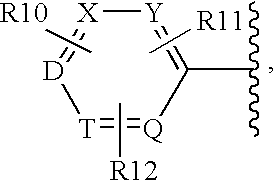Oxazole derivatives as histamine H3 receptor agents, preparation and therapeutic uses
a technology of histamine h3 receptor and oxazole derivative, which is applied in the field of new drugs, can solve the problems of poor blood-brain barrier penetration of imidazole-containing compounds, hepatic and ocular toxicities, and unsatisfactory side effects, and achieves selective and high affinity binding.
- Summary
- Abstract
- Description
- Claims
- Application Information
AI Technical Summary
Benefits of technology
Problems solved by technology
Method used
Image
Examples
example 1
2-(4-Bromo-phenyl)-4-pyrrolidin-1-ylmethyl-oxazole
[0401]
[0402]2-(4-Bromo-phenyl)-4-chloromethyl-oxazole (See Intermediate 1) (0.321 g, 1.18 mmol), and pyrrolidine (0.639 g, 9.0 mmol) are dissolved in 20 mL tetrahydrofuran and stirred at ambient temperature for 1.5 hours. The reaction is concentrated to an oil and redissolved in diethyl ether which is washed with aqueous sodium bicarbonate, water, separated and dried over sodium sulfate, filtered and concentrated to a dark oil. The oil is purified by flash silica gel chromatography (2% 2M NH3 in MeOH / dichloromethane) to give 0.185 g of the titled compound. MS (m / e) (81Br): 309.1 (M+1)
example 2
2-(4-Bromo-phenyl-4-pyrrolidin-1-ylmethyl-oxazole; hydrochloride
[0403]
[0404]The free base of the titled compound is prepared substantially in accordance the procedure of Example 1 without chromatography. The crude free base is treated with 1M HCl in diethyl ether and the resulting solids are dissolved a minimum amount of dichloromethane. Diethyl ether is added and the brown precipitate is removed by filtration. To the filtrate is added 1:1 diethyl ether / hexane to precipitate the titled compound as a light tan solid. MS (m / e) (81Br): 309.1 (M+1)
example 3
3-[4-(4-Pyrrolidin-1-ylmethyl-oxazol-2-yl)-phenyl]-pyridine; dihydrochloride
[0405]
[0406]Step A: 2-(4-Bromo-phenyl)-4-pyrrolidin-1-ylmethyl-oxazole (See Example 1) (0.174 g, 0.57 mmol), 3-pyridylboronic acid (0.184 g, 1.5 mmol), dichloropalladium di-triphenylphosphine (0.060 g, 0.086 mmol), cesium fluoride (0.866 g, 5.7 mmol) and 6 mL acetonitrile are placed in a 10 mL CEM microwave tube. The tube is placed in a CEM microwave reactor for 30 minutes at 140° C., 125 psi, and 75 watts of power. The mixture is cooled and concentrated to a dark residue which is purified by radial silica gel chromatography (1% 2M NH3 in MeOH / dichloromethane) to give 0.015 g of the free base of the titled compound.
[0407]Step B: The free base is dissolved in 1 mL of dichloromethane and 0.20 mL of a 1M HCl in diethyl ether solution is added to precipitate 0.018 g of the pure titled compound. MS (m / e): 306.1 (M+1)
PUM
| Property | Measurement | Unit |
|---|---|---|
| temperature | aaaaa | aaaaa |
| temperature | aaaaa | aaaaa |
| temperature | aaaaa | aaaaa |
Abstract
Description
Claims
Application Information
 Login to View More
Login to View More - R&D
- Intellectual Property
- Life Sciences
- Materials
- Tech Scout
- Unparalleled Data Quality
- Higher Quality Content
- 60% Fewer Hallucinations
Browse by: Latest US Patents, China's latest patents, Technical Efficacy Thesaurus, Application Domain, Technology Topic, Popular Technical Reports.
© 2025 PatSnap. All rights reserved.Legal|Privacy policy|Modern Slavery Act Transparency Statement|Sitemap|About US| Contact US: help@patsnap.com



